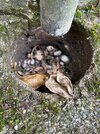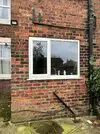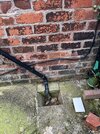You are using an out of date browser. It may not display this or other websites correctly.
You should upgrade or use an alternative browser.
You should upgrade or use an alternative browser.
Airbrick and damp, 1890s house
- Thread starter Craig24
- Start date
Sponsored Links
Photo of the “drain” also, not had time to clear any further as of yet
Attachments
I'd agree with that.Water coming from your boiler, or plumbing pipes? The apex of the wet patch is 4-5 o'clock from the boiler exhaust.
Lift the slabs as I reckon you'll find some lashed up soakaway has failed.
I also have some damp on an internal wall between the living room and the hall. It looks like it’s had this issue before as it has an injection dpc, I believe the floor has been filled in with concrete, there are some original airbricks at the front, they are right at the external ground level. Could this be causing damp? I wasn’t sure as if it’s been concreted there is no need for them?


Sponsored Links
There might be some bridging of the dpc (or lack of it) because the grey/blue membrane in the second pic of the original post is not lapped into the wall. The gulley/soakaway may not have failed but got blocked with leaves moss etc over time and the surface water has spread across the slabs and into the wall, so that is the first thing to address.
Blup
Blup
I also have some damp on an internal wall between the living room and the hall. It looks like it’s had this issue before as it has an injection dpc, I believe the floor has been filled in with concrete, there are some original airbricks at the front, they are right at the external ground level. Could this be causing damp? I wasn’t sure as if it’s been concreted there is no need for them?
Silicone injections are rubbish. They do not repair leaking pipes or broken drains. As you have seen, they do not cure damp. Filling in a damp gap with concrete provides a path for water to soak into, and prevents it escaping. Unlike a ventilated void, it prevents water evaporating away and drying out. A house of that age may also have a leaking water pipe on the route between the outside stopcock and where the kitchen sink used to be.
The ground level has been raised since the house was built.
Sadly your house has all the ineffective bodges, without a repair to the broken drain that has the source of the problem for generations.
Even more sadly, this is quite common.
If you repair the cause, the house will start to dry out. Don't waste time and money on anything else until you have done that.
Thanks! The suspected broken drain and the internal wall and at the back and the front of the house, could they be the same problem?
I asked about the airbricks at the front in case that’s letting water in and causing damp at the front? I can take some photos, just not sure if it matters if the floors been concreted?
I asked about the airbricks at the front in case that’s letting water in and causing damp at the front? I can take some photos, just not sure if it matters if the floors been concreted?
I think the broken drain will be the cause of the severe damp next to it.
Damp on an internal wall away from that may have a different cause. The incoming water pipe often runs under the hall floor. If you locate the external stopcock it will give a clue of the route. Less commonly it enters from the rear of the house. If you are on a slope, the water may run downhill from its source.
Hundred-year old pipes often leak.
Damp on an internal wall away from that may have a different cause. The incoming water pipe often runs under the hall floor. If you locate the external stopcock it will give a clue of the route. Less commonly it enters from the rear of the house. If you are on a slope, the water may run downhill from its source.
Hundred-year old pipes often leak.
Get the drain sorted out and the concrete taken back from the wall.
Identify the cause of the broken/blocked gully, check/install install a physical dpc and lap the damp proof membrane over it.Thanks Blup. Is there anyway I can fix that issue on the internal wall. Should I be removing the bricks one by one for example, and taping and lapping?
Blup
I’ve not noticed them spilling but I’ve only had the house a few The bathroom and kitchen drains are round the corner. Once I’ve lifted and investigated the drain / soak away, i’ll look to put the condensate pipe round the corner and into same drain.Where are the bathroom and kitchen drains, and the gutter downpipe?
Do any of the gutters spill in heavy rain?
Attachments
The garden wall and the house wall at the back both look dark and damp. The gully at the back is also a long way below the current paving level. So either the gully has sunk (this happens when they leak, because they are very heavy so they sink into the soft wet mud) or the level has been raised above the DPC.
Or very likely both.
Plenty more digging for you!
Or very likely both.
Plenty more digging for you!
DIYnot Local
Staff member
If you need to find a tradesperson to get your job done, please try our local search below, or if you are doing it yourself you can find suppliers local to you.
Select the supplier or trade you require, enter your location to begin your search.
Please select a service and enter a location to continue...
Are you a trade or supplier? You can create your listing free at DIYnot Local
Sponsored Links




